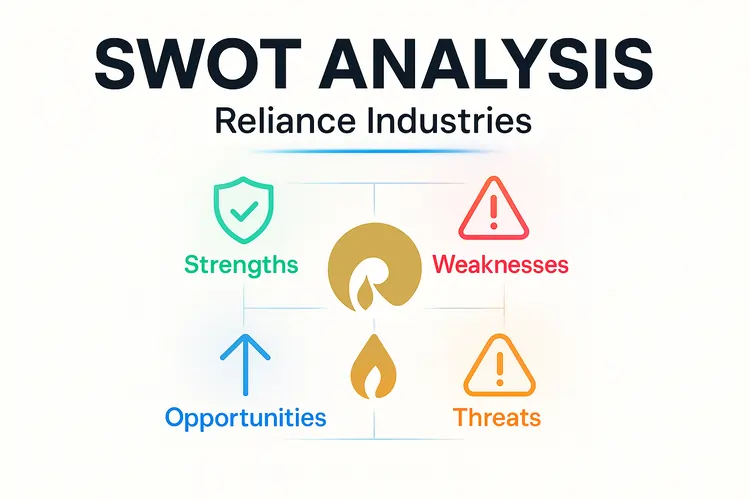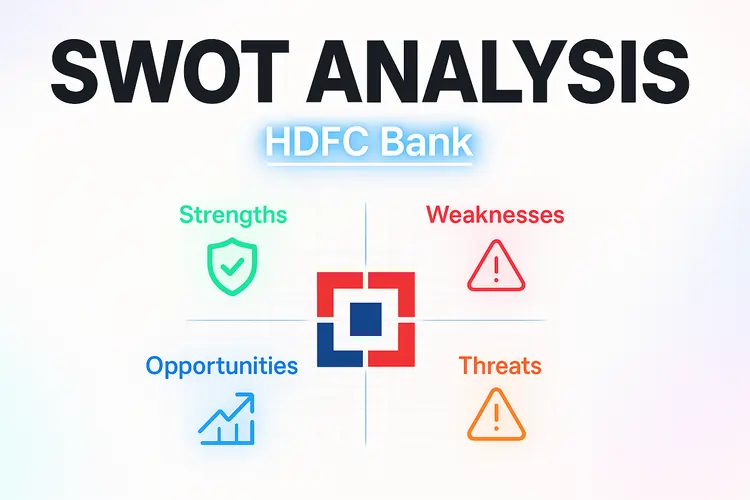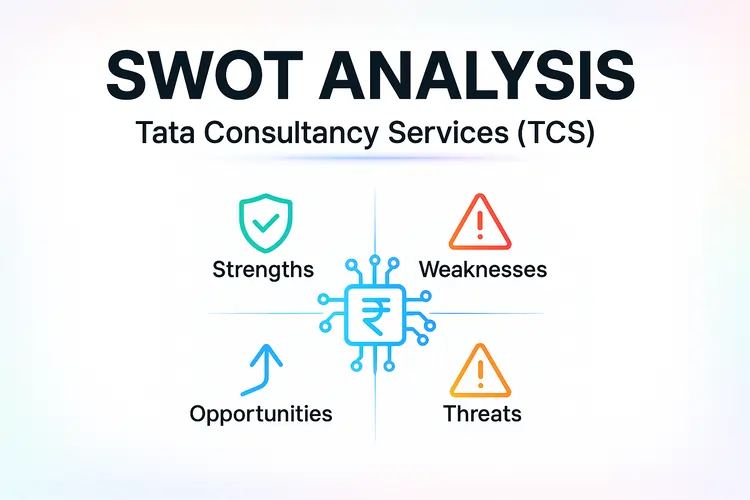
TCS SWOT analysis 2025 examines strengths, weaknesses, opportunities, and threats of India’s largest IT services company.
Tata Consultancy Services leads global IT services, consulting, and digital transformation across major industries and geographies.
TCS serves BFSI, retail, manufacturing, healthcare, telecom, and technology clients with large multi-year transformation deals.
The company operates at massive scale, with strong margins, healthy order books, and a diversified client portfolio.
North America and Europe drive revenues, while India, APAC, and MEA add resilience and growth optionality.
Cloud modernization, data platforms, cybersecurity, and GenAI solutions remain key TCS growth themes in 2025.
As Deepak Singh, Founder of The DM School, I present this analysis for business leaders and students.
For cross-industry perspective, see our Dmart SWOT analysis contrasting retail scale with technology services.
Strengths of TCS (Tata Consultancy Services)
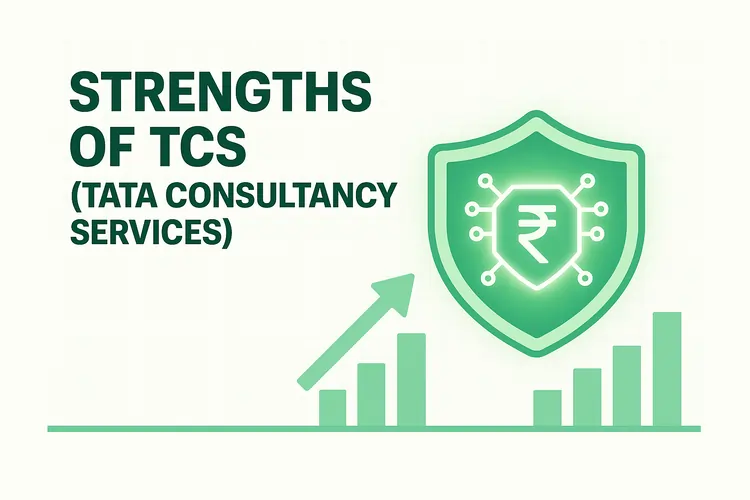
The strengths of TCS show why it remains India’s most valuable IT company and a global leader in digital transformation.
From margins to mega deals, TCS combines scale, stability, and innovation to maintain industry leadership in 2025.
- Unmatched scale and brand trust:
TCS employs over 613,000 professionals across 150+ nationalities. This scale gives it unmatched delivery capacity and credibility in winning global transformation contracts. - Consistent profitability:
With an operating margin of 24.5% and net margin of 20.1% in Q1 FY26, TCS remains one of the most profitable IT service providers worldwide. Such margins give it resilience in downturns. - Robust client base:
TCS services 1,336+ clients above $1 million in annual revenue, with 62 clients above $100 million. This diversified base reduces dependency on any single account. - Strong order book and mega deals:
A $9.4B TCV in Q1 FY26 and a €550M, 7-year mega deal with Tryg highlight its ability to secure long-duration, high-value engagements. - Innovation and GenAI leadership:
Partnerships with Google Cloud and NVIDIA, plus nearly 9,000 patents filed, keep TCS at the forefront of AI, cloud, and automation-driven services. - Geographic and sector balance:
North America contributes ~49% of revenues, while BFSI remains its largest vertical at 32%. Such diversification provides revenue stability across markets. - Talent management:
With attrition at 13.8%, well below industry highs, and 15M learning hours delivered in a year, TCS maintains one of the most skilled and stable workforces in IT services.
🔥 Pro Tip: TCS’s edge comes from combining global scale with consistent profitability. Few IT companies manage both at this level, which is why it dominates mega deals.
These TCS strengths underline how scale plus innovation fuel leadership, similar to market strategies we explored in our HDFC Bank SWOT analysis.
Summary: TCS strengths include unmatched scale, high margins, diversified client base, mega deals, GenAI leadership, sector balance, and a skilled workforce.
Weaknesses of TCS
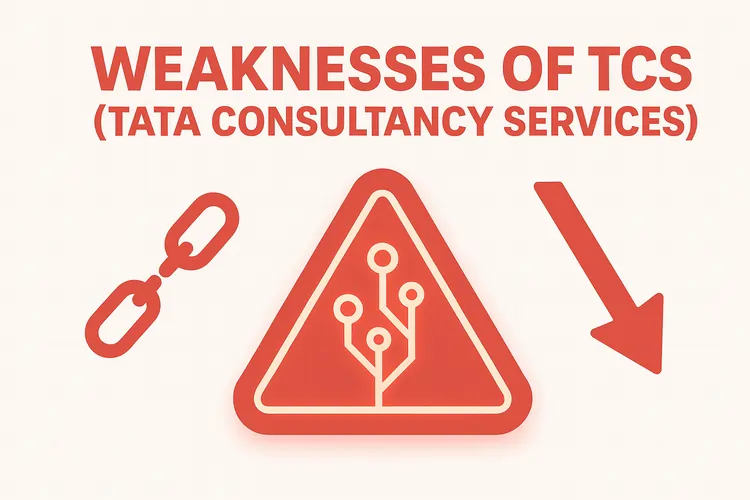
The weaknesses of TCS reveal the challenges that can limit growth momentum, despite its scale and profitability.
While TCS is India’s IT giant, it still faces issues in revenue growth, regional exposure, and talent management.
- Slowing revenue growth:
In Q1 FY26, revenue declined 3.1% in constant currency YoY. This shows that even a giant like TCS is vulnerable to global demand softness and delayed client decisions. - Overdependence on BFSI and North America:
BFSI contributes 32% of revenue, while North America brings ~49%. Any slowdown in US banks or regulatory shocks can disproportionately affect TCS revenues. - Volatility in India geography:
India business saw a steep 21.7% decline YoY in Q1 FY26. While small in mix, such swings highlight weak pricing power in domestic markets. - TCV momentum below peak:
Total contract value of $9.4B in Q1 FY26 was healthy but lower than the $12.2B achieved in Q4 FY25, raising concerns about deal pipeline consistency. - Talent cost pressures:
Wage hikes were delayed until September 2025, signaling cost control challenges. Such actions can hurt morale and retention, especially in a competitive IT labor market. - Innovation execution risks:
While TCS invests in GenAI and partnerships with Google Cloud and NVIDIA, converting pilots into large-scale revenues remains an uncertain journey.
📊 TCS vs Peers: Margins & Growth (Q1 FY26)
- TCS: Revenue -3.1% CC YoY | Op Margin 24.5%
- Infosys: Revenue +1.3% CC YoY | Op Margin ~21%
- Wipro: Revenue -2% CC YoY | Op Margin ~16%
TCS leads in profitability but lags peers like Infosys in revenue momentum.
These TCS weaknesses mirror challenges of scale in fast-changing industries, similar to pressures highlighted in our ICICI Bank SWOT analysis.
Summary: Weaknesses include slowing revenue growth, BFSI dependence, volatile geographies, TCV fluctuations, wage cost pressures, and execution risks in innovation.
Opportunities for TCS
The opportunities of TCS reflect rising enterprise demand for cloud, data, cybersecurity, and GenAI at global scale.
With large account relationships and strong delivery, TCS can convert pilots into multi-year transformation programs.
- GenAI at scale:
Enterprises are moving from proofs to production. TCS can package industry agents, MLOps, and safety layers to win platform-wide GenAI rollouts. - Cloud modernization and FinOps:
Legacy estates require refactoring, data lakes, and cost governance. TCS can bundle modernization, SRE, and FinOps to expand deal sizes and stickiness. - Vertical consolidation deals:
Tight tech budgets push vendor consolidation. With deep BFSI, manufacturing, and life sciences playbooks, TCS can capture larger, end-to-end mandates. - Cybersecurity expansion:
Compliance and zero-trust demand managed detection, identity, and OT security. TCS can scale MDR and platform alliances into annuity revenues. - Europe and UK recovery:
Improving macro sentiment and renewals open room for application, data, and ERP refresh programs led by value-based pricing. - Engineering and ER&D services:
Automakers, med-tech, and telecom need software-defined products. TCS can grow high-margin ER&D, digital twins, and 5G network automation. - Pricing and IP-led solutions:
Converting frameworks into products and platforms enables premium pricing, faster deployments, and better renewal leverage.
🌟 TCS Growth Drivers
- 🤖 GenAI platforms: Industry agents, governance, and MLOps at scale.
- ☁️ Cloud + FinOps: Refactor, optimize, and manage hybrid estates.
- 🛡️ Cyber managed services: MDR, IAM, and OT security annuities.
- 🏭 ER&D momentum: Software-defined products and digital twins.
These TCS opportunities echo how integrated offers win markets, similar to lessons in our YouTube Ads strategy guide.
Summary: Opportunities include GenAI production deals, cloud modernization, consolidation wins, cybersecurity annuities, European recovery, ER&D growth, and IP-led pricing power.
Threats to TCS
The threats of TCS underline the external and internal risks that can slow momentum even for India’s IT leader.
Global macro shifts, pricing pressures, and talent costs remain the key factors that could erode profitability and growth.
- Global demand volatility:
Revenue fell 3.1% CC YoY in Q1 FY26. Weak discretionary spending in BFSI and Europe shows how macro cycles hit deal flows. - Pricing pressure in renewals:
With $13B contracts up for renewal across the industry by Dec 2025, competitive bidding may compress margins even for incumbents like TCS. - Overexposure to BFSI and North America:
BFSI (32%) and North America (~49%) dominate revenue. Regulatory shocks or US economic slowdown could drag growth sharply. - Talent cost inflation:
Delayed wage hikes highlight internal cost control. But rising attrition or union pushback could raise expenses and hurt delivery quality. - Execution risk in GenAI:
Clients demand ROI on GenAI pilots. If TCS fails to scale projects into annuities, rivals may seize leadership in next-gen tech. - Currency and geopolitical risk:
Forex swings, oil shocks, or policy barriers in key geographies can erode profits and delay expansion plans.
🔥 Pro Tip: For TCS, the biggest risk isn’t size—it’s execution at scale. Converting GenAI and mega deals into recurring, profitable streams will decide if it stays ahead of Infosys and Accenture.
These TCS threats are reminders of how leadership carries risks, just as seen in our SBI SWOT analysis where scale also creates vulnerabilities.
Summary: Threats include demand volatility, renewal pricing pressure, BFSI dependence, talent inflation, GenAI execution risks, and geopolitical exposure.
TCS Key Metrics Snapshot 2025
Use this snapshot for quick facts on Tata Consultancy Services.
Figures reflect FY25 and Q1 FY26 disclosures.
| Metric | Value | Period |
|---|---|---|
| Revenue (FY25) | $30.18 billion | FY25 |
| Revenue (quarter) | $7.421 billion | Q1 FY26 |
| Operating margin | 24.5% | Q1 FY26 |
| Net margin | 20.1% | Q1 FY26 |
| Order book (TCV) | $9.4 billion | Q1 FY26 |
| Headcount | 613,069 | Q1 FY26 |
| Attrition (LTM) | 13.8% | Q1 FY26 |
| Clients $100M+ | 62 | Q1 FY26 |
| BFSI revenue mix | 32.0% | LTM to Q1 FY26 |
| North America mix | 48.7% | LTM to Q1 FY26 |
| Patents filed / granted | 8,987 / 4,939 | Q1 FY26 |
| Dividend (interim) | ₹11 per share | FY26 (record: Jul 16, 2025) |
Profitability momentum
High
Order book health
Strong
Geo diversification
Broad
BFSI dependence
Elevated
Talent stability
Improving
Conclusion of TCS SWOT Analysis 2025
The TCS SWOT analysis 2025 shows why Tata Consultancy Services remains a benchmark in the IT services industry. With unmatched scale, consistent profitability, and a global delivery footprint, it continues to set industry standards.
Strengths like 24.5% operating margins, $9.4B order book, and 613k employees give TCS a dominant foundation. Weaknesses such as BFSI dependence, demand volatility, and wage cost pressures highlight areas to watch closely.
Opportunities in GenAI, cloud modernization, cybersecurity, and ER&D can expand long-term growth, while threats like pricing pressure, global demand cycles, and execution risks could challenge performance if not managed well.
As Deepak Singh, Founder of The DM School, I see TCS as a case study in how Indian companies can scale globally while balancing profitability and innovation. For professionals and students, it’s a playbook on adapting to shifting technologies while keeping fundamentals strong.
For sector-wide comparison, also explore our ICICI Bank SWOT analysis, showing how financial services and technology leaders share common lessons in scale and resilience.
Summary: TCS combines scale, profitability, and innovation strength, but must navigate BFSI dependence, pricing pressure, and execution risks to maintain leadership in 2025.
TCS SWOT – FAQs
What is TCS?
Tata Consultancy Services (TCS) is India’s largest IT services company and a global leader in consulting, digital transformation, cloud, and AI solutions. With a workforce of 613,000 professionals across 50+ countries, TCS serves industries such as banking, retail, telecom, manufacturing, and healthcare.
What is the TCS SWOT analysis 2025?
The TCS SWOT analysis 2025 examines the company’s strengths, weaknesses, opportunities, and threats based on FY25 and Q1 FY26 performance. It evaluates profitability, order book, sector mix, talent, innovation, and competitive challenges in global IT services.
What are the main strengths of TCS?
TCS strengths include consistent profitability with 24.5% operating margin, $9.4B order book in Q1 FY26, a diversified client base of 1,336+ large accounts, strong BFSI presence, global brand trust, low attrition compared to peers, and innovation leadership through GenAI and partnerships with Google Cloud and NVIDIA.
What are the weaknesses of TCS?
TCS weaknesses include overdependence on BFSI (32% revenue) and North America (~49% revenue), slowing growth with -3.1% constant currency decline in Q1 FY26, India revenue volatility (-21.7%), and talent cost pressures due to delayed wage hikes. Innovation risks also exist as GenAI pilots must convert into scalable revenues.
What opportunities lie ahead for TCS?
TCS opportunities include enterprise adoption of GenAI, large-scale cloud modernization programs, cybersecurity demand, engineering and ER&D services for 5G and automotive, European recovery, and mega consolidation deals as clients seek fewer vendors. IP-led pricing models can further improve margins and renewal leverage.
What are the threats faced by TCS?
TCS threats include global demand volatility, pricing pressure during contract renewals, BFSI overexposure, rising wage inflation, talent attrition risk, execution challenges in scaling AI projects, and exposure to currency/geopolitical risks that affect profitability and delivery.
What was the revenue of TCS in FY25?
TCS revenue in FY25 was $30.18 billion, supported by strong order wins of $39.4 billion TCV. Despite global uncertainty, TCS maintained a 24.3% operating margin, showcasing operational excellence and scale advantage.
What was TCS revenue in Q1 FY26?
In Q1 FY26, TCS revenue stood at $7.421 billion, a decline of 3.1% in constant currency YoY. Despite the dip, the company maintained a healthy operating margin of 24.5% and net margin of 20.1%.
What is the TCS order book?
The TCS order book stood at $9.4 billion in Q1 FY26. This included $4.4 billion from North America and $2.5 billion from BFSI. While lower than Q4 FY25’s $12.2 billion, it still reflects strong demand for long-duration engagements.
How many employees work at TCS?
TCS workforce totals 613,069 employees as of Q1 FY26. The company added 6,071 employees YoY, with 35.1% women in the workforce and representation from 151 nationalities. Attrition remains at a stable 13.8% LTM, lower than most IT peers.
What is TCS’s client base?
TCS client base includes 1,336+ clients above $1 million revenue, 495 clients above $10 million, and 62 clients above $100 million. This diverse portfolio reduces risk and provides opportunities for cross-sell and upsell across industries.
Which sectors drive TCS revenue?
BFSI is TCS’s largest vertical at 32% of revenue, followed by consumer (15.6%), life sciences & healthcare (10.2%), manufacturing (8.7%), and technology services (8.4%). BFSI dominance provides scale but also increases cyclical risk.
Which geographies contribute most to TCS?
North America contributes 48.7% of revenue, followed by the UK (18%) and Continental Europe (15%). India contributes 5.8%, APAC 8.4%, and MEA 2.2%. This geographic spread gives TCS resilience but also dependence on Western markets.
What is the role of GenAI at TCS?
GenAI is central to TCS’s strategy, with industry-specific agents, MLOps pipelines, and safety frameworks. Collaborations with Google Cloud (Gemini Experience Center) and NVIDIA strengthen TCS’s ability to deliver enterprise AI solutions at scale.
What is TCS’s margin performance?
TCS operating margin was 24.5% and net margin 20.1% in Q1 FY26, among the highest in the global IT services industry. This reflects efficient delivery, strong pricing, and scale economics even during revenue slowdowns.
What is the attrition rate at TCS?
TCS attrition was 13.8% LTM in Q1 FY26, significantly lower than peers. Continuous upskilling with 15 million learning hours and a stable HR framework help TCS manage talent retention better than many competitors.
What are the major deals won by TCS recently?
In September 2025, TCS secured a €550M (7-year) mega deal with Tryg, one of Europe’s largest insurance firms. Such long-duration contracts reinforce TCS’s ability to handle consolidation and digital transformation at scale.
What is TCS’s dividend policy?
TCS declared an interim dividend of ₹11 per share for FY26, with record date July 16, 2025, and payout on August 4, 2025. The company consistently rewards shareholders with regular dividends, reflecting strong cash generation.
What is the future outlook for TCS?
The future outlook for TCS is positive, driven by GenAI adoption, cloud modernization, cybersecurity services, and IP-led platforms. However, challenges like BFSI overdependence, pricing pressure in renewals, and global demand cycles could test resilience in 2025.
